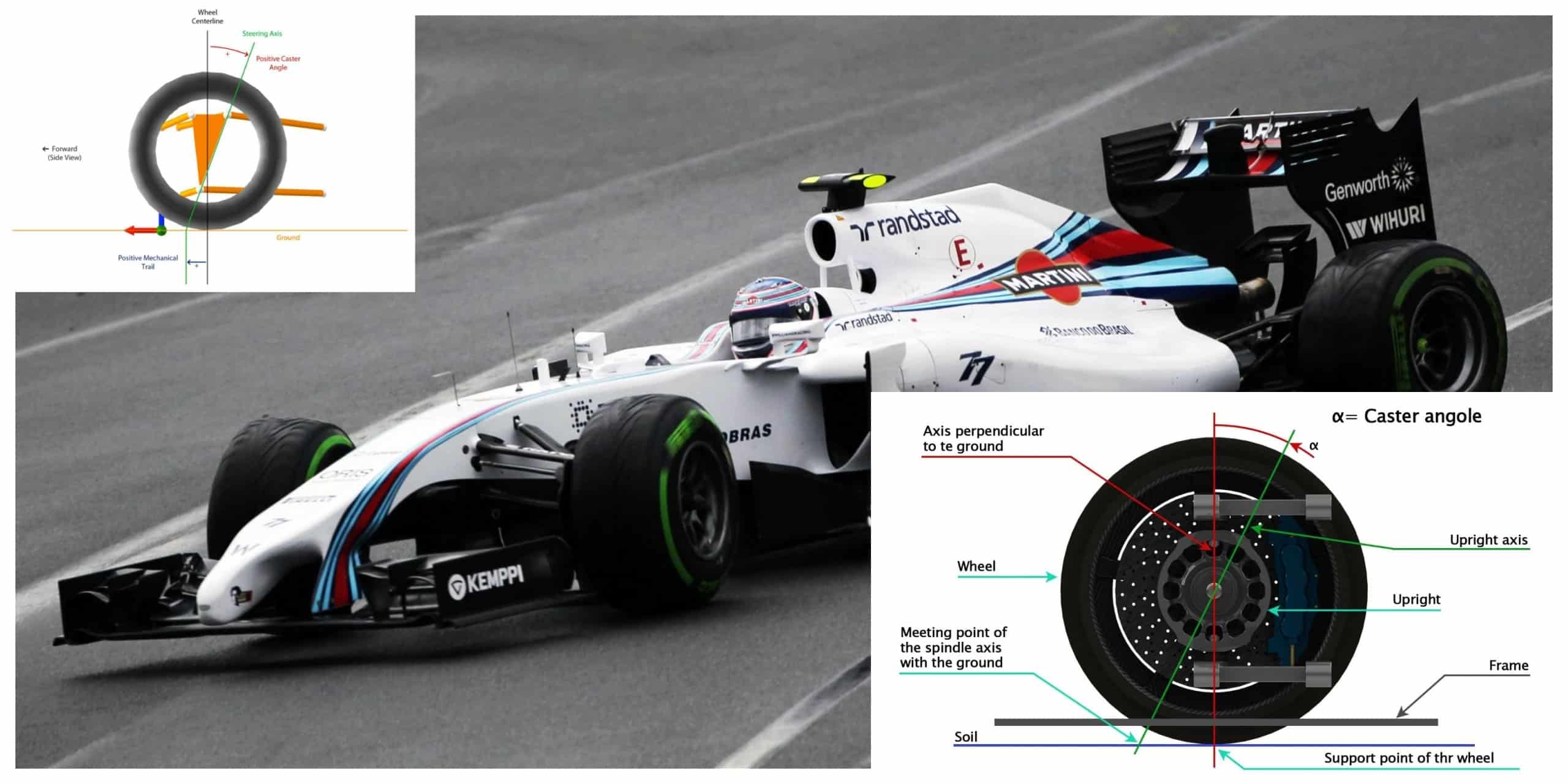What is caster angle?
The caster angle explained and its influence in Motorsport
We continue our journey in the world of tyres and suspension: caster. Now it’s the time for Caster to be analyzed. Did you miss the lessons about camber and toe? Find them out in our mechanical lessons!
What is the Caster angle?
The caster angle is the angular displacement of the steering axis from the vertical axis of a steered wheel in a vehicle measured in the longitudinal direction. It is the angle between the pivot line (in a car an imaginary line that runs through the center of the upper ball joint to the center of the lower ball joint) and vertical. In automobile racing, positive caster angle may be adjusted to optimize handling characteristics for a particular venue.
Positive or negative caster angle explained.
If the pivot axis is tilted backward (that is, the top pivot is positioned farther rearward than the bottom pivot), then the caster is positive; if it’s tilted forward, then the caster is negative.
The caster angle on a car.
In the automotive field, negative caster gives no feedback to the driver in terms of wheel position. It is also the type of caster that is used on a shopping trolley (or hospital beds, office chairs…) and is the reason why wheels can wobble and turn easily. (The real caster is zero because the wheel patch is simply offset from the vertical and there is no relative angle between the steering axis and vertical, but we can compare this example to a wheel with negative camber for the position of the pivot).
Disadvantages of a negative caster angle.
A further disadvantage of negative caster is that it will increase under braking conditions making the steering more unstable (the so called “caster flutter”) due to the car pitching forward.
The only notable advantage to having negative caster is that the steering input effort required is very low making the steering very easy to turn.
One advantage of using zero caster is that it retains the slight reduction in kingpin torque before reaching the limit of adhesion, which is useful for a driver to know when the limit is near. Also, zero caster provides easy steering input without the extreme instability of using negative caster.
Positive caster angle: the self-aligning torque.
Positive caster creates a self-aligning torque. This increases the stability of the vehicle in straight line situations, increasingly important at high speeds. The firm and stable steering provides the driver with confidence and allows them to drive at higher straight-line speeds as they are not fighting the steering wheel. This self-aligning torque also pulls the wheels back to a straight line when exiting a corner allowing the driver to be much smoother on corner exit, controlling the rate that the wheels return to center.
READ: HOW F1 DRS WORKS EXPLAINED
The advantages of positive caster angle on a race car.
So, focused on racing cars and on positive camber, we can resume the two primary benefits:
- Improved straight-line stability at speed. The front wheels positioned forward of the upper ball joint/strut mount produces a self-aligning torque on the front wheels and tires. This is a fairly complicated engineering concept, but the idea is that positive caster creates a tension that wants to return/keep the front wheels pointed straight ahead while at speed. This makes a vehicle easier to control and improves its directional stability.
- Improved vehicle handling and cornering performance. Caster has a direct relationship to negative camber, which is fundamental to maximizing the tire’s contact patch when cornering, and therefore key to maximizing the available grip. Specifically, positive caster helps to create increased negative camber on the outside wheel during cornering.
Caster influence on Camber angle: the turn condition.
When cornering, the vehicle weight shift is met with a maximization of the tire contact patch on the outside front wheel that’s under maximum cornering load. So, since the wheel rotates about a tilted axis, the wheel gains camber as it is turned. This effect is best visualized by imagining the unrealistically extreme case where the steering axis would be horizontal-as the steering wheel is turned, the road wheel would simply change camber rather than direction. This effect causes the outside wheel in a turn to gain negative camber, while the inside wheel gains positive camber. These camber changes are generally favorable for cornering, although it is possible to overdo it. In performance driving circles a caster increase – sometimes to the maximum available setting that the vehicle will accommodate – is credited with improvements in vehicle handling, maximum traction, and steering responsiveness.
Caster and camber angle relation on car performance.
The main disadvantage to positive caster is that the steering requires a higher amount of input effort to turn the wheel. However with power steering systems this is not an issue. Also, for a racing driver where there often is no power steering, the heavy input is tolerated for the increased stability and smoother corner exits; obviously, excessive caster angle will make the steering heavier and less responsive. We can state that caster angles over 7 degrees with radial tires are common.
What to read more about tyres and suspension: camber? Check our related articles below!








